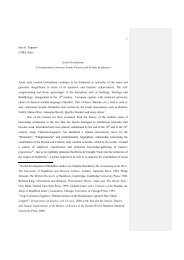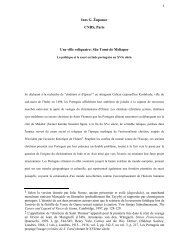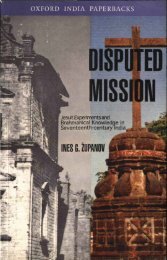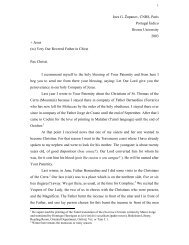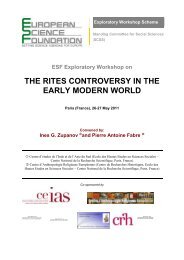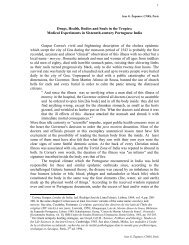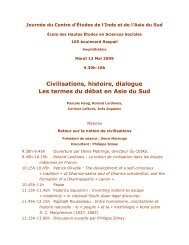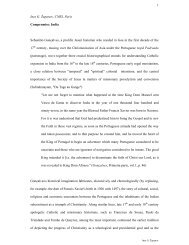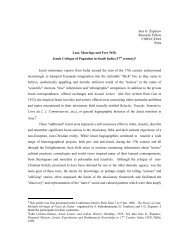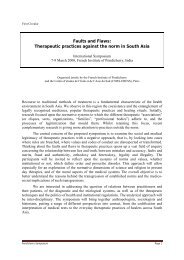Professional Missionary and Orientalist Curator ... - Ines G. Županov
Professional Missionary and Orientalist Curator ... - Ines G. Županov
Professional Missionary and Orientalist Curator ... - Ines G. Županov
You also want an ePaper? Increase the reach of your titles
YUMPU automatically turns print PDFs into web optimized ePapers that Google loves.
214 <strong>Ines</strong> <strong>Županov</strong><br />
conclusions that India, not Egypt or Greece, was the most antique<br />
civilization was not so different from, neither irreconcilable with,<br />
other scholars <strong>and</strong> writers such as William Jones whose texts he knew<br />
well. By 1798, Paulinus’s comparative method produced one of the<br />
first studies on the kinship of Indo-European languages 34 . In his De<br />
antiquitate et affinitate linguae Zendicae, Samscrdamicae et Germanicae<br />
dissertatio, Paulinus juxtaposes linguistic forms in Sanskrit, Avestan<br />
<strong>and</strong> German in order to prove the existence of kinship between these<br />
languages 35 . In fact, Paulinus set out to prove with examples Jones’s<br />
famous claim in 1786 of the common origin of Greek, Latin <strong>and</strong> Sanskrit,<br />
but it was not until 1802 before he finally came up with decisive<br />
pronouncement on the issue 36 . Thus, he wrote in his De latini sermonis<br />
origine, both Sanskrit, Zend <strong>and</strong> Latin possess between them «an intimate<br />
affinity» <strong>and</strong> resemble as «one egg to another» 37 .<br />
Sanskrit, in Paulinus’s opinion, contained truth on the one h<strong>and</strong>,<br />
<strong>and</strong> many lies on the other. As a repository of the Brahmanical high<br />
learning, it also wove into it monstrous «fables» <strong>and</strong> corrupted the<br />
pristine message (presumably Christian, of course). Paulinus was in<br />
34<br />
Jauk-Pinhak, Some Notes cit., p. 136.<br />
35<br />
Paulinus a S. Bartholomaeo, De antiquitate et affinitate linguae Zendicae, Samscrdamicae<br />
et Germanicae dissertatio..., Patavii, Typis seminarii 1798 [1799].<br />
36<br />
The similarity between Latin <strong>and</strong> Sanskrit was noticed very early. Filippo Sassetti<br />
who visited India between 1583 <strong>and</strong> 1588 described Sanskrit as a language with<br />
a well ordered grammar <strong>and</strong> containing words that resembled Italian. He also hinted<br />
at the fact that it was perhaps India the cradle of all languages. D.F. Lach, Asia in the<br />
Making of Europe, 3 vols., Chicago-London, University of Chicago Press 1965-1977,<br />
II (1970), 3, p. 520. French Jesuits such as J.F. Pons, J. Calmette <strong>and</strong>, in particular,<br />
P.-G. Coeurdoux were some of the most learned Sanskritists of the first half of the<br />
18 th century. Coeurdoux may have been the first to report in 1767 on the close family<br />
resemblance between Greek, Latin <strong>and</strong> Sanskrit terms. This letter was sent to<br />
the members of the Académie Royal des Inscription et des Belles-Lettres in Paris.<br />
S. Murr, L’Inde philosophique entre Bossuet et Voltaire, l’indologie du Père Coeurdoux;<br />
stratégies, apologétique et scientificité, 2 vols., Paris, Ecole française d’Extrême-Orient<br />
1987, II, p. 29.<br />
37<br />
Jauk-Pinhak, Some notes cit. Paulinus a S. Bartholomaeo, De latini sermonis<br />
origine et cum orientalibus linguis connectione dissertatio..., Romae, Fulgonius 1802. A<br />
ten page manuscript copy of the article with slight differences can be found in Rome,<br />
BNVE, Rari e manoscriti, Fondi minori, Santa Maria della Scala, 36 (C), p. 2. The<br />
date on the manuscript is 1801. There is another copy ibid., 34, pp. 58-77.




